

|
|
Δείτε εδώ τα πιο πρόσφατα μηνύματα από όλες τις περιοχές συζητήσεων, καθώς και όλες τις υπηρεσίες της AcroBase. H εγγραφή σας είναι γρήγορη και εύκολη. |
|
|||||||
|
 |
|
|
Εργαλεία Θεμάτων | Τρόποι εμφάνισης |
 |
#3571
|
 |
|
||||
|
Discover the cosmos! Each day a different image or photograph of our fascinating universe is featured, along with a brief explanation written by a professional astronomer. 2016 July 7 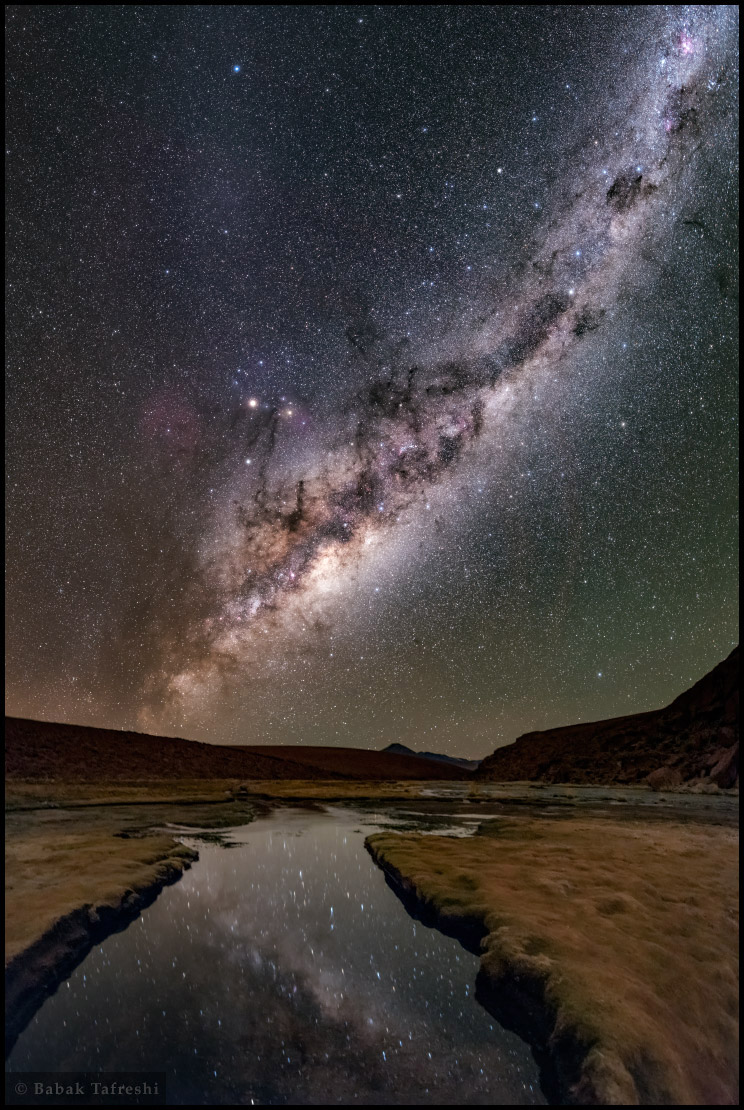 Image Credit & Copyright: Babak Tafreshi (TWAN) Explanation: The Milky Way is massively bright on this cold, clear, altiplano night. At 4,500 meters its reflection in a river, a volcanic peak on the distant horizon, is captured in this stitched panorama under naturally dark skies of the northern Chilean highlands near San Pedro de Atacama. Along the Solar System's ecliptic plane, the band of Zodiacal light also stands out, extending above the Milky Way toward the upper left. In the scene from late April, brilliant Mars, Saturn, and Antares form a bright celestial triangle where ecliptic meets the center of the Milky Way. Left of the triangle, the large purple-red emission nebula Sharpless 2-27, more than twenty Moon diameters wide is centered around star Zeta Ophiuchi.
__________________
όταν γράφεται η ιστορία της ζωής σου, μην αφήνεις κανέναν να κρατάει την πένα |
 |
#3572
|
 |
|
||||
|
Discover the cosmos! Each day a different image or photograph of our fascinating universe is featured, along with a brief explanation written by a professional astronomer. 2016 July 8  Image Credit: NASA, ESA - Acknowledgment: J. Hester (ASU), M. Weisskopf (NASA / GSFC) Explanation: At the core of the Crab Nebula lies a city-sized, magnetized neutron star spinning 30 times a second. Known as the Crab Pulsar, it's actually the rightmost of two bright stars, just below a central swirl in this stunning Hubble snapshot of the nebula's core. Some three light-years across, the spectacular picture frames the glowing gas, cavities and swirling filaments bathed in an eerie blue light. The blue glow is visible radiation given off by electrons spiraling in a strong magnetic field at nearly the speed of light. Like a cosmic dynamo the pulsar powers the emission from the nebula, driving a shock wave through surrounding material and accelerating the spiraling electrons. With more mass than the Sun and the density of an atomic nucleus, the spinning pulsar is the collapsed core of a massive star that exploded. The Crab Nebula is the expanding remnant of the star's outer layers. The supernova explosion was witnessed on planet Earth in the year 1054.
__________________
όταν γράφεται η ιστορία της ζωής σου, μην αφήνεις κανέναν να κρατάει την πένα |
 |
#3573
|
 |
|
||||
|
Discover the cosmos! Each day a different image or photograph of our fascinating universe is featured, along with a brief explanation written by a professional astronomer. 2016 July 9 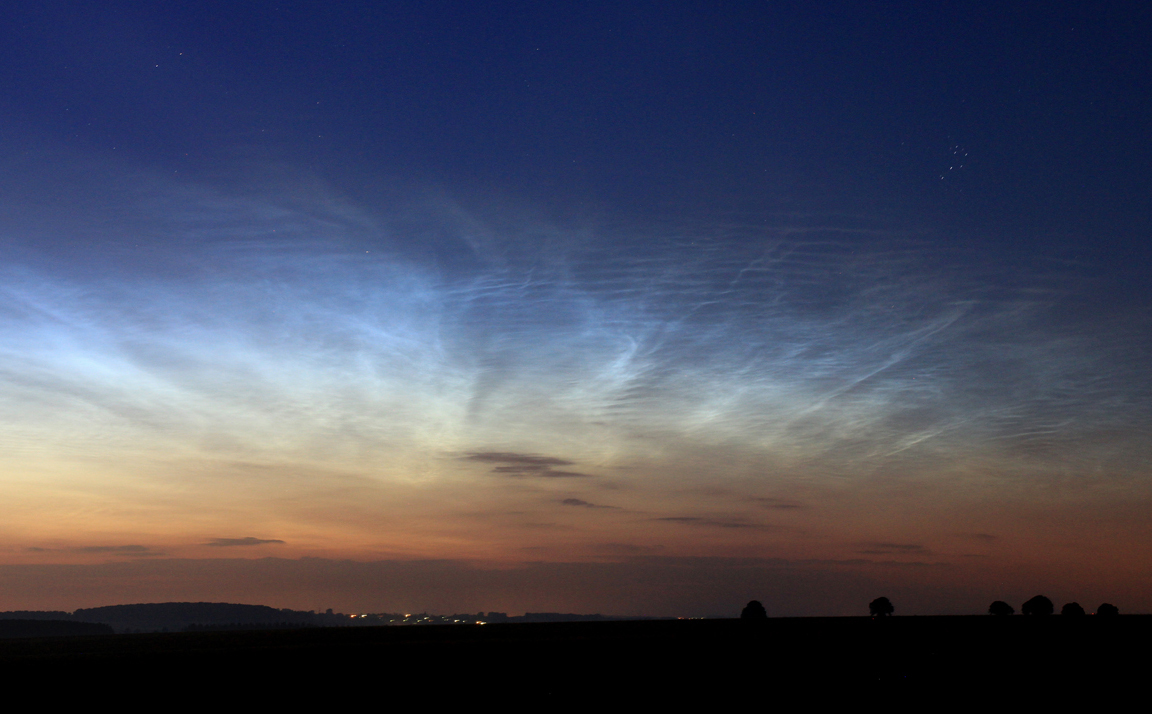 Image Credit & Copyright: Simon Lericque (GAAC) Explanation: Bright noctilucent or night shining clouds are not familiar sights from northern France. But these electric-blue waves coursed through skies over the small town of Wancourt in Pas-de-Calais on July 6, just before the dawn. From the edge of space, about 80 kilometers above Earth's surface, the icy clouds still reflect sunlight even though the Sun itself is below the horizon as seen from the ground. Usually spotted at high latitudes in summer months the diaphanous apparitions are also known as polar mesospheric clouds. The seasonal clouds are understood to form as water vapor driven into the cold upper atmosphere condenses on the fine dust particles supplied by disintegrating meteors or volcanic ash. NASA's AIM mission provides projections of the noctilucent clouds as seen from space.
__________________
όταν γράφεται η ιστορία της ζωής σου, μην αφήνεις κανέναν να κρατάει την πένα |
 |
#3574
|
 |
|
||||
|
Discover the cosmos! Each day a different image or photograph of our fascinating universe is featured, along with a brief explanation written by a professional astronomer. 2016 July 10 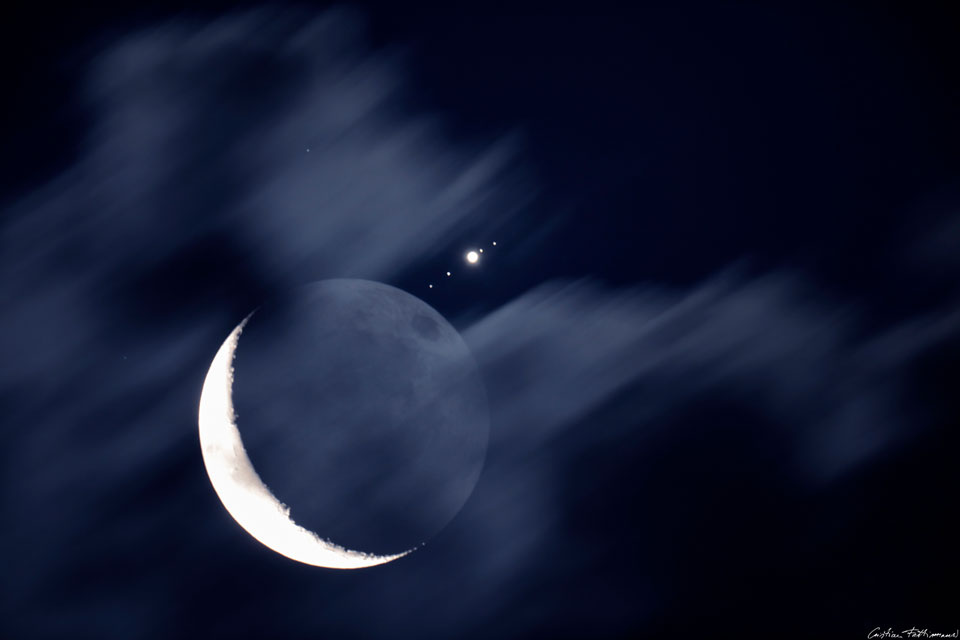 Image Credit & Copyright: Cristian Fattinnanzi Explanation: What's that next to the Moon? Jupiter -- and its four largest moons. Skygazers around planet Earth enjoyed the close encounter of planets and Moon in 2012 July 15's predawn skies. And while many saw bright Jupiter next to the slender, waning crescent, Europeans also had the opportunity to watch the ruling gas giant pass behind the lunar disk, occulted by the Moon as it slid through the night. Clouds threaten in this telescopic view from Montecassiano, Italy, but the frame still captures Jupiter after it emerged from the occultation along with all four of its large Galilean moons. The sunlit crescent is overexposed with the Moon's night side faintly illuminated by Earthshine. Lined up left to right beyond the dark lunar limb are Callisto, Ganymede, Jupiter, Io, and Europa. In fact, Callisto, Ganymede, and Io are larger than Earth's Moon, while Europa is only slightly smaller. Last week, NASA's Juno became the second spacecraft ever to orbit Jupiter. Transparent Science: Browse 1,250+ codes in the Astrophysics Source Code Library
Tomorrow's picture: open space Πηγή
__________________
όταν γράφεται η ιστορία της ζωής σου, μην αφήνεις κανέναν να κρατάει την πένα |
 |
#3575
|
 |
|
||||
|
Discover the cosmos! Each day a different image or photograph of our fascinating universe is featured, along with a brief explanation written by a professional astronomer. 2016 July 11 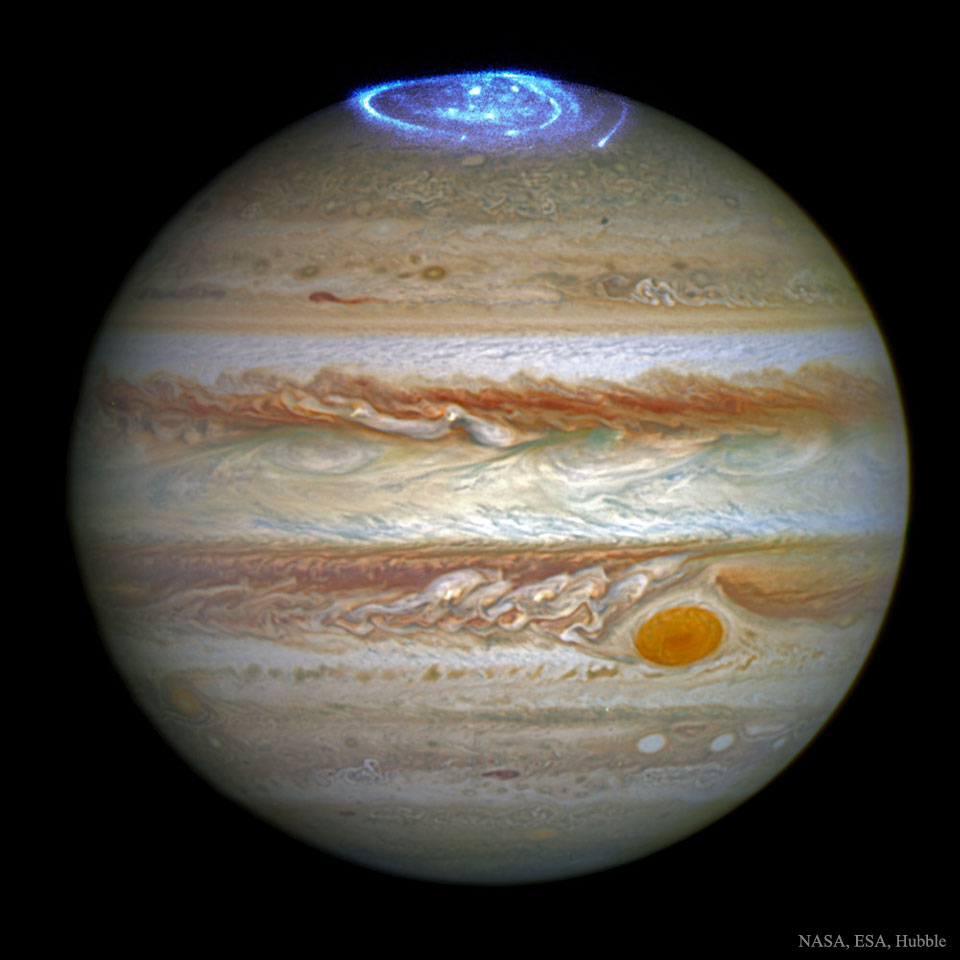 Image Credit: NASA, ESA, Hubble Explanation: Jupiter has aurorae. Like Earth, the magnetic field of the gas giant funnels charged particles released from the Sun onto the poles. As these particles strike the atmosphere, electrons are temporarily knocked away from existing gas molecules. Electric force attracts these electrons back. As the electrons recombine to remake neutral molecules, auroral light is emitted. In the featured recently released composite image by the Hubble Space Telescope taken in ultraviolet light, the aurorae appear as annular sheets around the pole. Unlike Earth's aurorae, Jupiter's aurorae include several bright streaks and dots. Jupiter's Great Red Spot is visible on the lower right. Recent aurorae on Jupiter have been particularly strong -- a fortunate coincide with the arrival of NASA's Juno spacecraft at Jupiter last week. Juno was able to monitor the Solar Wind as it approached Jupiter, enabling a better understanding of aurorae in general, including on Earth.
__________________
όταν γράφεται η ιστορία της ζωής σου, μην αφήνεις κανέναν να κρατάει την πένα |
 |
#3576
|
 |
|
||||
|
Discover the cosmos! Each day a different image or photograph of our fascinating universe is featured, along with a brief explanation written by a professional astronomer. 2016 July 12 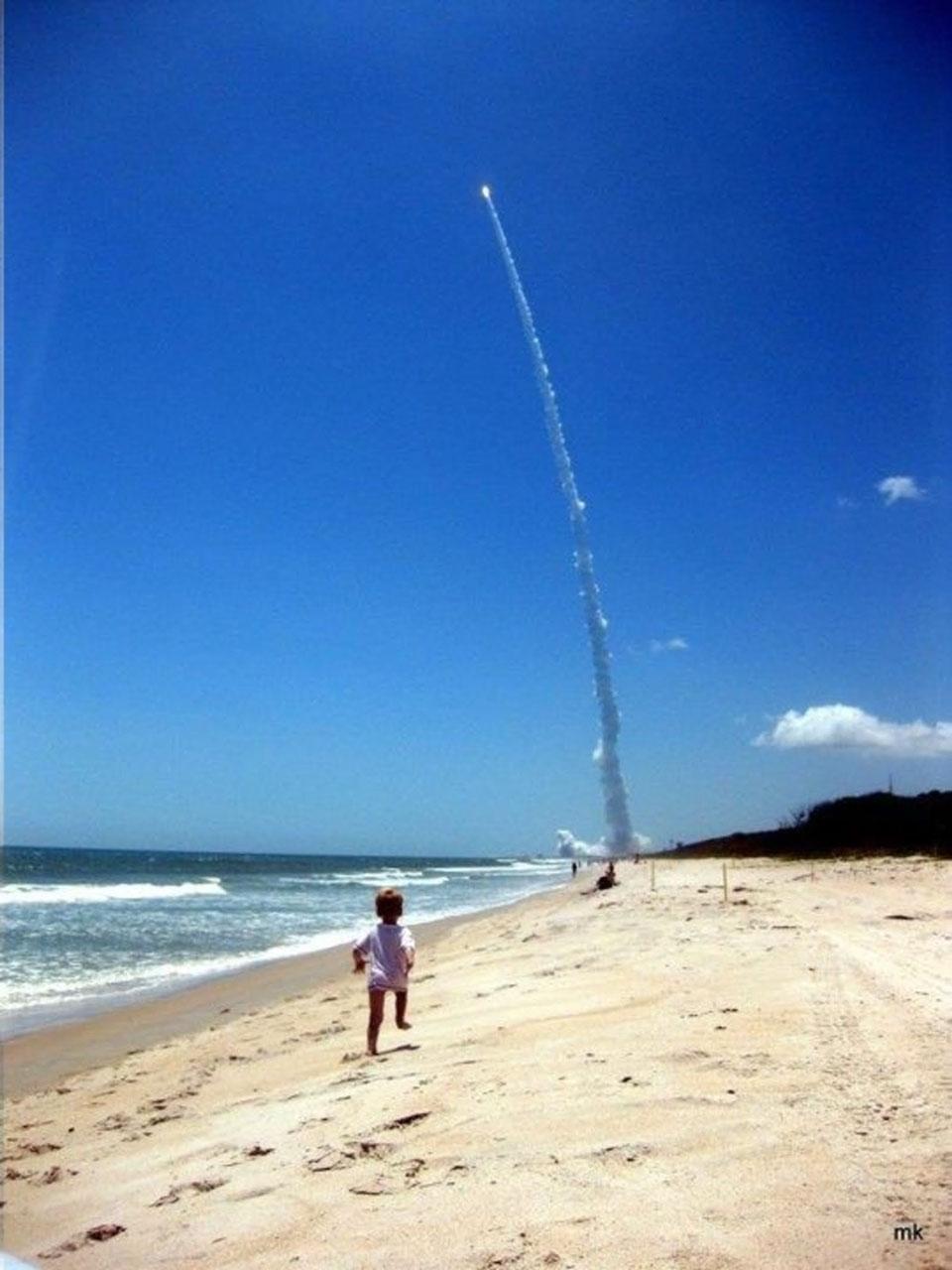 Image Credit & Copyright: Melissa Christine Kendall Explanation: Wait for me! In 2011, NASA's robotic mission Juno launched for Jupiter from Cape Canaveral, Florida, USA. Last week, Juno reached Jupiter and fired internal rockets to become only the second spacecraft to orbit our Solar System's largest planet. Juno, tasked with studying the jovian giant over the next two years, is in a highly elliptical orbit that will next bringing it near Jupiter's cloud tops in late August. Of course, the three-year-old pictured was not able to catch up to the launching rocket. Today, however, five years later, he is eight-years-old and still chasing rockets -- in that now he wants to be an astronaut.
__________________
όταν γράφεται η ιστορία της ζωής σου, μην αφήνεις κανέναν να κρατάει την πένα |
 |
#3577
|
 |
|
||||
|
Discover the cosmos! Each day a different image or photograph of our fascinating universe is featured, along with a brief explanation written by a professional astronomer. 2016 July 13 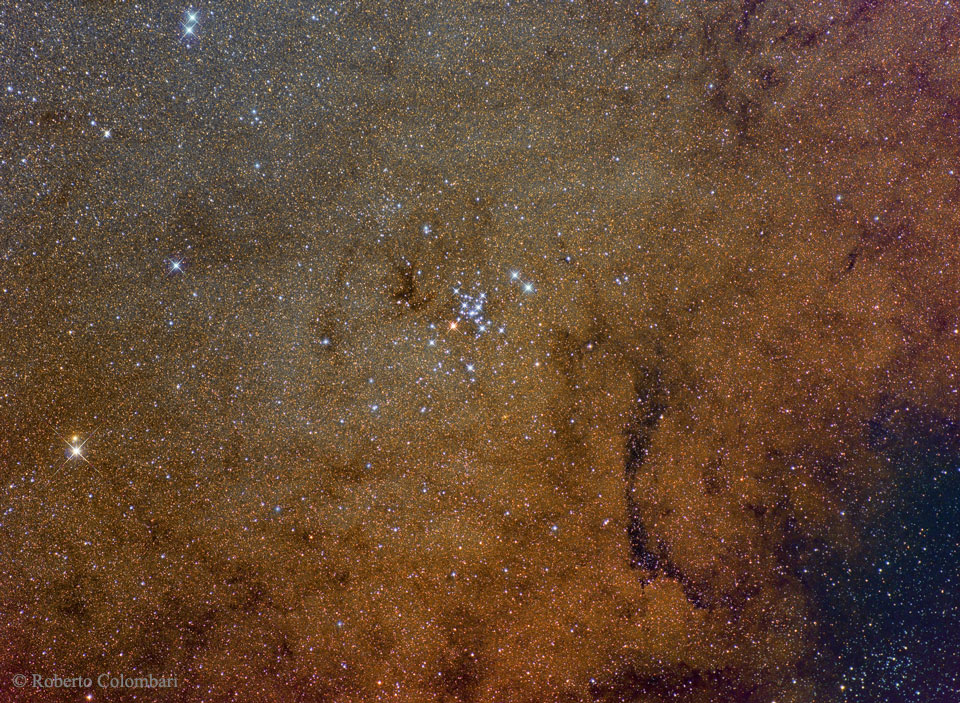 Image Credit & Copyright: Roberto Colombari Explanation: M7 is one of the most prominent open clusters of stars on the sky. The cluster, dominated by bright blue stars, can be seen with the naked eye in a dark sky in the tail of the constellation of the Scorpion (Scorpius). M7 contains about 100 stars in total, is about 200 million years old, spans 25 light-years across, and lies about 1000 light-years away. The featured wide-angle image was taken near the city of Belo Horizonte in Brazil. The M7 star cluster has been known since ancient times, being noted by Ptolemy in the year 130 AD. Also visible are a dark dust cloud on the lower right, and, in the background, literally millions of unrelated stars towards the Galactic center.
__________________
όταν γράφεται η ιστορία της ζωής σου, μην αφήνεις κανέναν να κρατάει την πένα |
 |
#3578
|
 |
|
||||
|
Discover the cosmos! Each day a different image or photograph of our fascinating universe is featured, along with a brief explanation written by a professional astronomer. 2016 July 14 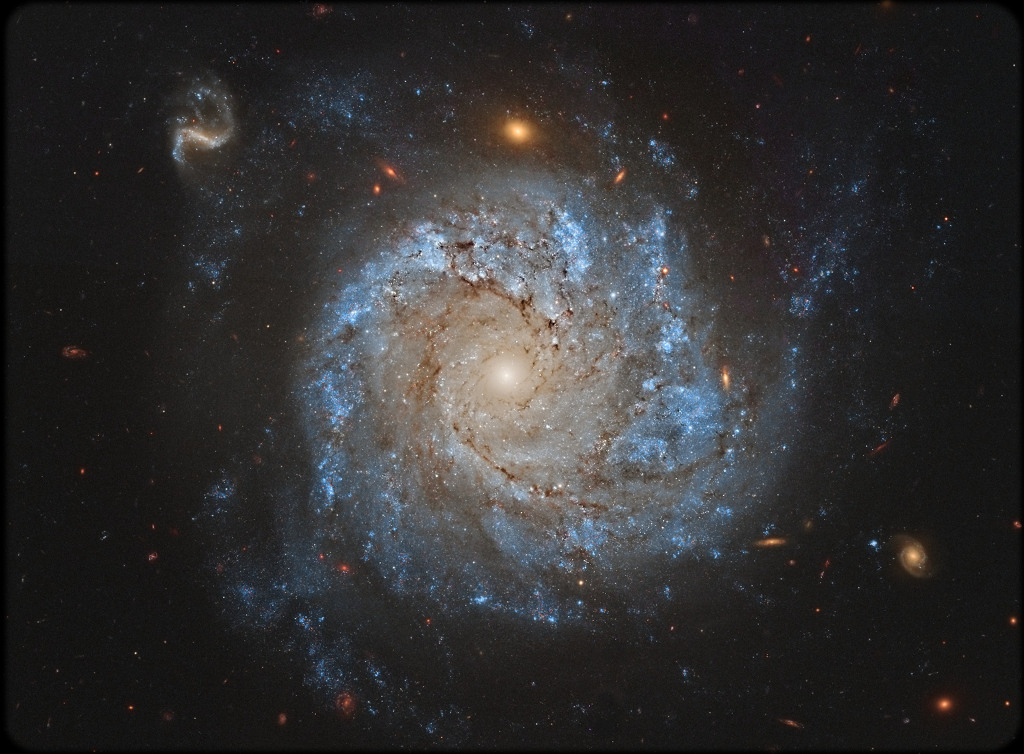 Image Credit: Hubble Legacy Archive, ESA, NASA; Processing - Jeff Signorelli Explanation: A gorgeous spiral galaxy some 100 million light-years distant, NGC 1309 lies on the banks of the constellation of the River (Eridanus). NGC 1309 spans about 30,000 light-years, making it about one third the size of our larger Milky Way galaxy. Bluish clusters of young stars and dust lanes are seen to trace out NGC 1309's spiral arms as they wind around an older yellowish star population at its core. Not just another pretty face-on spiral galaxy, observations of NGC 1309's recent supernova and Cepheid variable stars contribute to the calibration of the expansion of the Universe. Still, after you get over this beautiful galaxy's grand design, check out the array of more distant background galaxies also recorded in this sharp, reprocessed, Hubble Space Telescope view.
__________________
όταν γράφεται η ιστορία της ζωής σου, μην αφήνεις κανέναν να κρατάει την πένα |
 |
#3579
|
 |
|
||||
|
Discover the cosmos! Each day a different image or photograph of our fascinating universe is featured, along with a brief explanation written by a professional astronomer. 2016 July 15 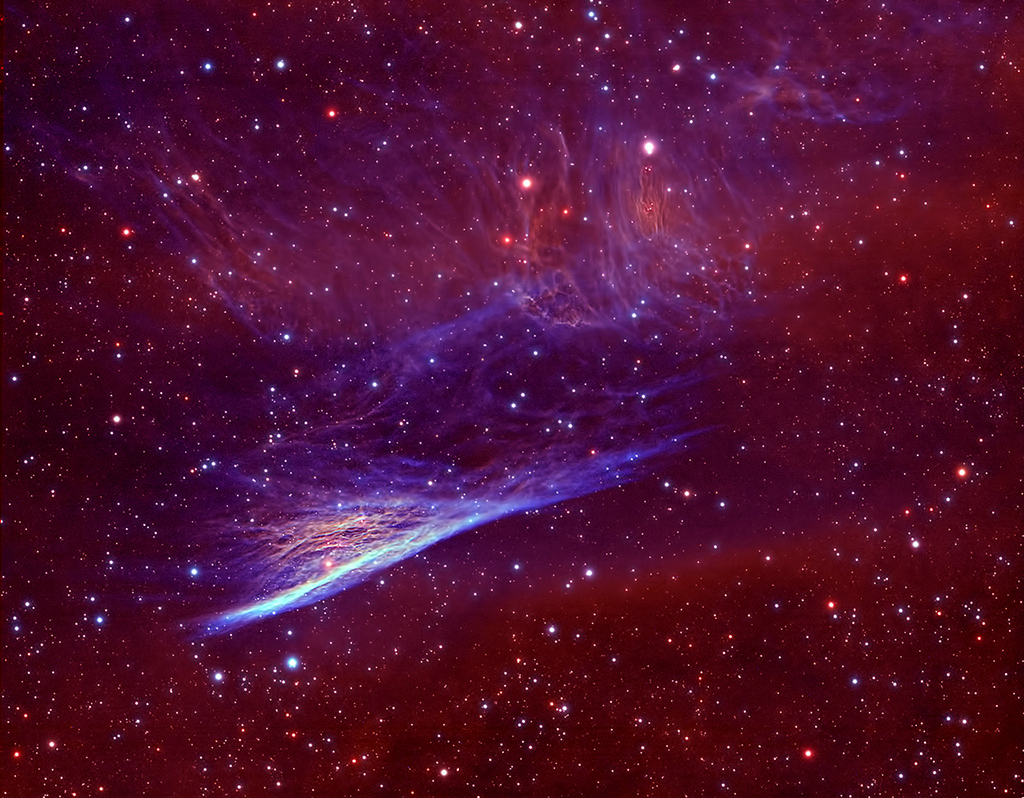 Image Credit & Copyright: Howard Hedlund & Dave Jurasevich, Las Campanas Obs. Explanation: Moving from top to bottom in the frame near the center of this sharply detailed color composite, thin, bright, braided filaments are actually long ripples in a cosmic sheet of glowing gas seen almost edge-on. The shock wave plows through interstellar space at over 500,000 kilometers per hour. Cataloged as NGC 2736, its elongated appearance suggests its popular name, the Pencil Nebula. The Pencil Nebula is about 5 light-years long and 800 light-years away, but represents only a small part of the Vela supernova remnant. The Vela remnant itself is around 100 light-years in diameter, the expanding debris cloud of a star that was seen to explode about 11,000 years ago. Initially, the shock wave was moving at millions of kilometers per hour but has slowed considerably, sweeping up surrounding interstellar material. In the narrowband, wide field image, red and blue-green colors track the characteristic glow of ionized hydrogen and oxygen atoms.
__________________
όταν γράφεται η ιστορία της ζωής σου, μην αφήνεις κανέναν να κρατάει την πένα |
 |
#3580
|
 |
|
||||
|
Discover the cosmos! Each day a different image or photograph of our fascinating universe is featured, along with a brief explanation written by a professional astronomer. 2016 July 16 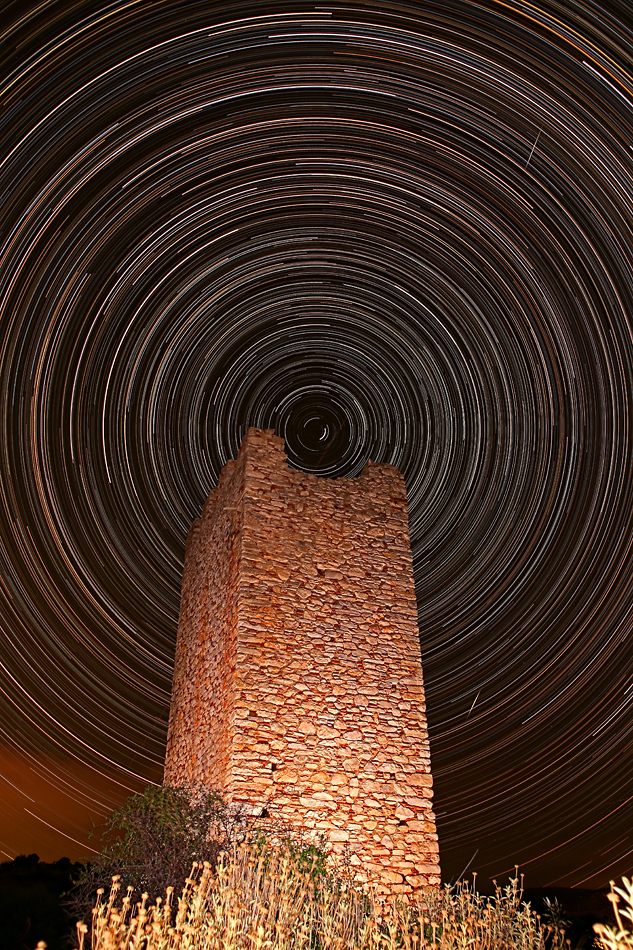 Image Credit & Copyright: Anthony Ayiomamitis (TWAN) Tomorrow's picture: mercury, horizontal Πηγή Σχόλιο : Είμαστε υπερήφανοι για την υπέροχη φωτογραφία του διάσημου αστροφωτογράφου Αντώνη Αγιομαμίτη.
__________________
όταν γράφεται η ιστορία της ζωής σου, μην αφήνεις κανέναν να κρατάει την πένα |
 |
#3581
|
 |
|
||||
|
Discover the cosmos! Each day a different image or photograph of our fascinating universe is featured, along with a brief explanation written by a professional astronomer. 2016 July 17 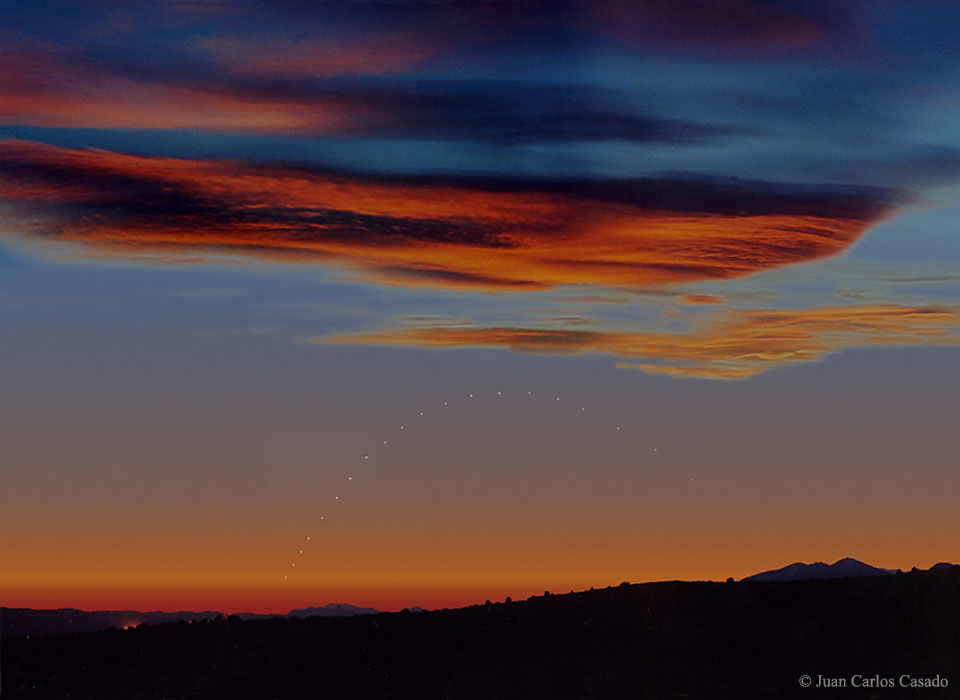 Image Credit & Copyright: Juan Carlos Casado Explanation: Have you ever seen the planet Mercury? Because Mercury orbits so close to the Sun, it never wanders far from the Sun in Earth's sky. If trailing the Sun, Mercury will be visible low on the horizon for only a short while after sunset. If leading the Sun, Mercury will be visible only shortly before sunrise. So at certain times of the year, informed skygazers with a little determination can usually pick Mercury out from a site with an unobscured horizon. Above, a lot of determination has been combined with a little digital manipulation to show Mercury's successive positions during March of 2000. Each picture was taken from the same location in Spain when the Sun itself was 10 degrees below the horizon and superposed on the single most photogenic sunset. Currently, Mercury is rising higher above the horizon with each passing sunset, and just now is angularly very close to the brighter planet Venus.
__________________
όταν γράφεται η ιστορία της ζωής σου, μην αφήνεις κανέναν να κρατάει την πένα |
 |
#3582
|
 |
|
||||
|
Discover the cosmos! Each day a different image or photograph of our fascinating universe is featured, along with a brief explanation written by a professional astronomer. 2016 July 18 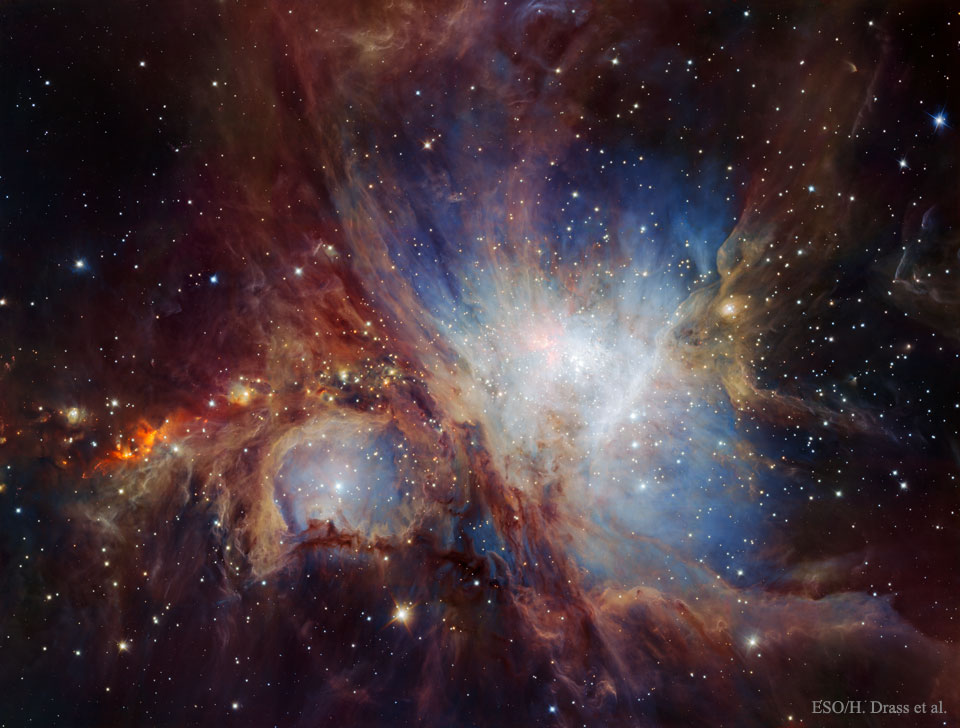 Image Credit: ESO, VLT, HAWK-I, H. Drass et al. Explanation: The deepest infrared image of the Orion Nebula has uncovered a bonanza of previously unknown low-mass stars and -- quite possibly -- free floating planets. The picturesque nebula is best known in visible light where it shows a many bright stars and bright glowing gas. Catalogued as M42, the Orion Nebula at a distance of 1300 light years is the closest major star forming region to Earth. One can peer into Orion's pervasive dust in infrared light, as was done again recently with the sophisticated HAWK-I camera attached to one of the European Southern Observatory's Very Large Telescopes in the high mountains of Chile. High resolution versions of the featured infrared deep image show many points of light, many of which are surely brown dwarf stars but some of which are best fit by an unexpectedly high abundance of free-floating planets. Understanding how these low mass objects formed is important to understanding star formation generally and may even help humanity to better understand the early years of our Solar System. Remastered version of this image: Recolored and in greater detail
Tomorrow's picture: color the universe Πηγή
__________________
όταν γράφεται η ιστορία της ζωής σου, μην αφήνεις κανέναν να κρατάει την πένα |
 |
#3583
|
 |
|
||||
|
Discover the cosmos! Each day a different image or photograph of our fascinating universe is featured, along with a brief explanation written by a professional astronomer. 2016 July 19 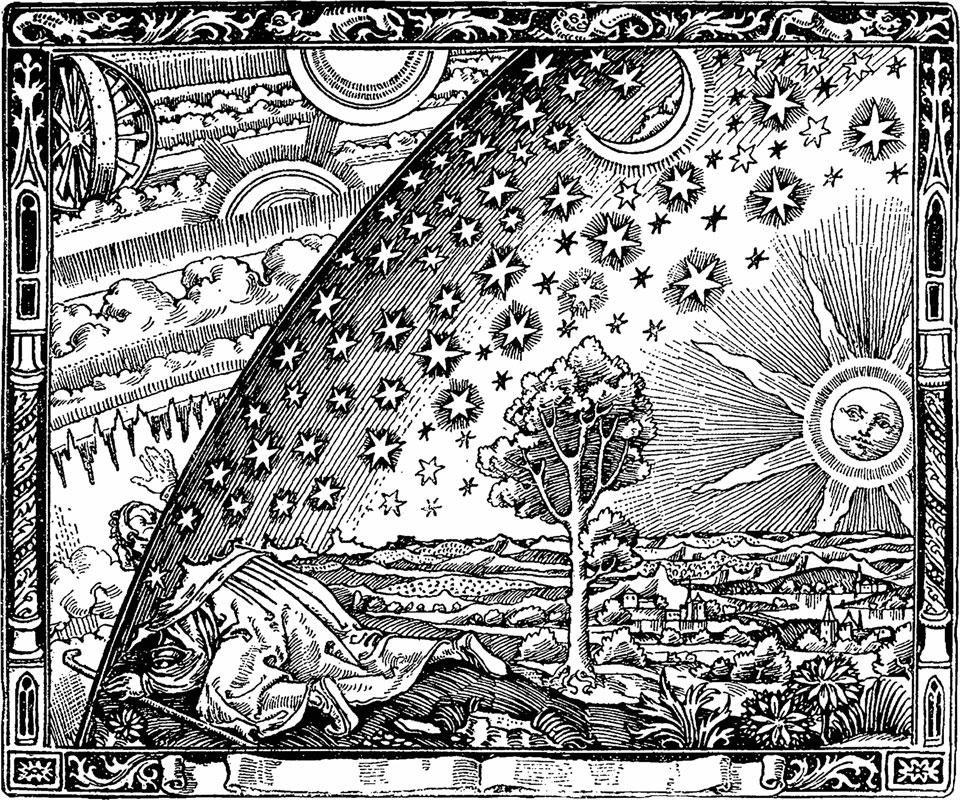 Image Credit: Unknown Explanation: Wouldn't it be fun to color in the universe? If you think so, please accept this famous astronomical illustration as a preliminary substitute. You, your friends, your parents or children, can print it out or even color it digitally. While coloring, you might be interested to know that even though this illustration has appeared in numerous places over the past 100 years, the actual artist remains unknown. Furthermore, the work has no accepted name -- can you think of a good one? The illustration, first appearing in a book by Camille Flammarion in 1888, is used frequently to show that humanity's present concepts are susceptible to being supplanted by greater truths.
__________________
όταν γράφεται η ιστορία της ζωής σου, μην αφήνεις κανέναν να κρατάει την πένα |
 |
#3584
|
 |
|
||||
|
Discover the cosmos! Each day a different image or photograph of our fascinating universe is featured, along with a brief explanation written by a professional astronomer. 2016 July 20 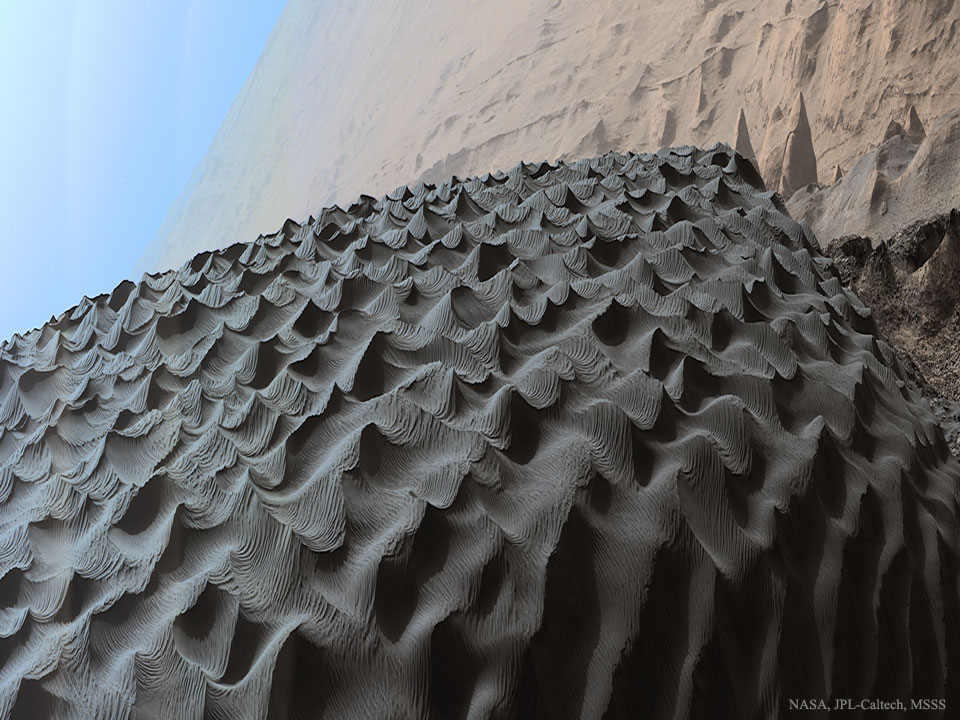 Image Credit: NASA, JPL-Caltech, MSSS Explanation: How does wind affect sand on Mars? To help find out if it differs significantly from Earth, the robotic Curiosity rover on Mars was directed to investigate the dark Namib Dune in the Bagnold Dune Field in Gale Crater. Namib is the first active sand dune investigated up close outside of planet Earth. Wind-created ripples on Earth-bound sand dunes appear similar to ripples on Mars, with one exception. The larger peaks visible on dark Namib dune, averaging about 3 meters apart, are of a type seen only underwater on Earth. They appear to arise on Mars because of the way the thin Martian wind drags dark sand particles. The featured image was taken last December and is horizontally compressed to show context. In the distance, a normal dusty Martian landscape slopes up in light orange, while a rock-strewn landscape is visible on the far right. Curiosity unexpectedly went into safe mode in early July, but it was brought out last week and has now resumed exploring the once lake-filled interior of Gale Crater for further signs that it was once habitable by microbial life.
__________________
όταν γράφεται η ιστορία της ζωής σου, μην αφήνεις κανέναν να κρατάει την πένα |
 |
#3585
|
 |
|
||||
|
Discover the cosmos! Each day a different image or photograph of our fascinating universe is featured, along with a brief explanation written by a professional astronomer. 2016 July 21  Image Credit & Copyright: Michael Seeley Explanation: Shortly after midnight on July 18 a SpaceX Falcon 9 rocket launched from Space Launch Complex 40 at Cape Canaveral Air Force Station, Florida, planet Earth. About 9 minutes later, the rocket's first stage returned to the spaceport. This single time exposure captures the rocket's launch arc and landing streak from Jetty Park only a few miles away. Along a climbing, curving trajectory the launch is traced by the initial burn of the first stage, ending near the top of the bright arc before stage separation. Due to perspective the next bright burn appears above the top of the launch arc in the photo, the returning first stage descending closer to the Cape. The final landing burn creates a long streak as the first stage slows and comes to rest at Landing Zone 1. Yesterday the Dragon cargo spacecraft delivered to orbit by the rocket's second stage was attached to the International Space Station.
__________________
όταν γράφεται η ιστορία της ζωής σου, μην αφήνεις κανέναν να κρατάει την πένα |
 |
| Συνδεδεμένοι χρήστες που διαβάζουν αυτό το θέμα: 12 (0 μέλη και 12 επισκέπτες) | |
|
|